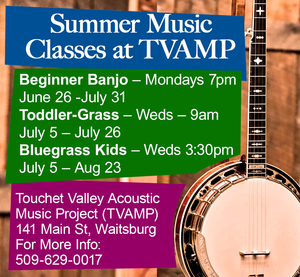What's In the Flour I Use for Baking?
July 19, 2018

Times File Photo
This sculpture by Jeffrey Hill, called "The Waitsburg Trilogy" and located on Waitsburg's Main Street in front of The Times' office, portrays three founders of Waitsburg moving sacks of wheat to Waits Mill.
As a bread maker, I've never given much thought to what types of wheat make what kind of flour. My use of baking flour consists of going to the store and getting all-purpose flour and occasionally, venturing out to whole wheat flour.
My knowledge of wheat was simply watching the hills go from green to gold. Until last year, I did not know how the wheat got into the grain elevators, visualizing some huge vacuum that took it from the truck to those large cylinders. The business side of me wondered who takes it from the grain elevators to the various customers.
What I thought was going to be simple answers made me realize how much I didn't know. I was buried in an information overload that held my interest.
Classes of wheat
I contacted Scott Yates with the Washington Grain Commission who was more than willing to share information about wheat. (See article on Page 11.) Yates is the director of communications and producer relations for the Washington Grain Commission (WGC). He shared that he produces an informative podcast called "Wheat All About It" (available at wagrains.org) for those who enjoy listening to podcasts. WGC also regularly has a section in the monthly magazine, Wheat Life.
There are six classes of wheat:
Soft White Wheat: Low protein-8 to 11%
Hard Red Winter Wheat-Higher protein about 12%
Hard Red Spring Wheat 14% protein, often mixed with Hard Red Winter Wheat.
Soft Red Winter Wheat-Also low protein
Hard White Wheat-12 percent protein, good for whole-grain
Durum – Used for making pasta products
Grain elevators
Summary and Definition: According to Wikipedia, Grain elevators were invented in 1842 by Joseph Dart and Robert Dunbar in Buffalo, N.Y. to address the problem of unloading and storing grain transported via the Erie Canal. Grain elevators were adapted to suit the loading and storage requirements of grains transported from farmland via the railroad.
The "Country Elevators" became known as the 'Sentinels of the Prairie," "Prairie Cathedrals" and "Prairie Skyscrapers."
When agriculture moved to a cash crop economy following the invention of the Cyrus McCormick Mechanical Reaper, it revolutionized farming methods, enabling wheat farmers to begin mass production of grain crops. Their problem was getting their grain to market that required long-distance distribution. The storage of grain and its transportation were both labor intensive and time consuming. Grain elevators, as we know them today, solved the problem.
Yates shared with me that each grain elevator's operator/owner contacts an exporter to sell their grain. The exporter has the responsibility to get it to their customers, for example, countries in the Pacific Rim.
Old Flour Mills
Old Waits Mill – When I googled this old four mill, I found that it was built in 1865, the five-story frame structure, including a mansard roof, was the eleventh flour mill built in eastern Washington, and the twenty-first built in Washington Territory, which came into being in 1852. The abandoned mill burned to the ground in Sept. 2009.
The well-known Pataha Flour Mill, near Pomeroy, and also known as Houser Mill, was built in 1878 by John Bauman and George Snyder. It has been restored, and tours are offered of the old building, which also has a "by donation" restaurant.
Oakesdale, Wash., has an old flour mill that also has been restored and turned into a museum. Old Mill Days this year, per the Whitman Gazette, were July 13-14.
Thankfully, with the help of Google and YouTube, I watched how they ground wheat into flour in these old flour mills. (YouTube has several videos of this process.) There is also a YouTube video on how wheat is made into the various types of flours. I encourage you, if you are interested, to also check out millpictures.com. It has pictures of old flour mills throughout the states. It is a fascinating part of the wheat history.
Types of Flour
The basic flour types, made from wheat are: White and Wheat All Purpose Flour, (Bleached and Unbleached), Bread Flour, Pastry Flour and Cake Flour. Rightfully named, all-purpose flour can be used for most baking needs. "What's Cooking America?" website says, "The type of flour used is vital at getting the right results in the end product. To achieve success in baking, it is important to know what the right flour is for the job!"
I decided to ask a few of our local bakers which types of flour they used. Their breads and pastries always taste so good.
Blue Mountain Outpost: "We use bread flour from Small's Family Farm. We find it to be the best and healthiest flour we can get for our breads."
Melissa Weatherford, Grassroots Catering: "I use unbleached white all-purpose from Smalls Family Farm and Joseph's Grainery."
Mandi Wendt, Weinhard Café: "We use Shepherd's Grain high gluten, all purpose, and whole wheat flour on a regular basis. The Shepherd's Grain flour is a co-op of wheat farmers in the Northwest. There is a code on each bag of flour, where you can enter it into their website, and it will tell you specifically which farm it came from.
Walla Walla Bread Company: "We use Small's Flour for our breads."
Aimee McGuire, Moose Creek Café: "We use Shepherd's Grain, High gluten, low gluten, pasty and all-purpose flour."
Carolyn Suffield, Carolyn's Café: "I use all-purpose flour, Bob Miller pastry flour and King Arthur flour."
And so it goes!! In my research, I have acquired some knowledge of the wheat industry, though space does not allow the many facets that could be shared.
I end this article with a quote from Small's Family Farm website. It pertains to homemade bread, but obviously flour is not just for bread.
"At its heart, bread baking is the art of turning dry, relatively flavorless ground grain into delicious food with great complexity and variety."













Reader Comments(0)